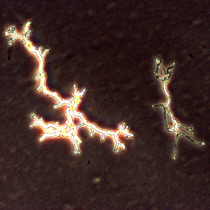Cell culture contamination - overview
|
You enter the lab in the best mood but already when removing your cultures form the incubator you suspiciously check the color and certainty hits you when you look at them under the microscope: contaminated! Who hasn't experienced this? Everyone working with cell culture has contamination once in a while. Bacteria, mycoplasma, yeast or fungi always find a way into our dishes or flasks. That's not embarrassing but rather normal. However, we should always ask ourselves where they come from, how they came into the culture and why. This trouble shooting will help us avoid contamination in the future. Every lab that frequently experiences contamination should review their general hygiene concept in the cell culture lab. In addition, figuring out what type of contamination it is helps identify the source of the contamination. |
 |
Types of cell culture contaminations
The word contamination is derived from the latin word for besmirched or dirty. Therefore, contamination in cell cultures is everything that does not belong there. This includes but is not limited to:
- Microbiological contaminations (e.g. bacteria, mycoplasmas, yeast, fungi)
- Viral contaminations (SMRV, CMV, EBV, HIV, HCV)
- Protein contamination (prions, allergens)
- Chemical contamination (leachables and extractables from plastic ware, heavy metals, endotoxins)
Sources of contamination
In most cases, the reason for contaminations is a mistake in aseptic technique. While newcomers usually make mistakes due to their lack of experience, the growing experience is what endangers long-term cell culturers. The faster we work and the more cultures we handle simultaneously, the riskier it becomes for contamination to appear. Below you can find a short list of tips that might help you to keep your cultures clean:
- Stress and aseptic technique don't go well together
- Always handle only one cell line and cell type in the hood
- Antibiotics cover mistakes. If you can't or don't want to leave them out, try to cultivate a line once in a while without antibiotics. This will help you realize mistakes and additionally, it allows "disguised" contamination (bacteria supressed by antibiotics, but present) to grow and become visible. This avoids transfer of contamination to other cultures.
- Document your contamination and try to classify them as far as possible. This might help to identify the source.
- If you have fungal contamination once in a while, check your incubator and whether the lab is regularly cleaned with other than alcoholic disinfectants.
- If you have yeast contamination more often in the summer, check your hygiene plan as yeast are usually brought to the lab from outside.
- If you want to be really safe, always test new batches of FCS for bacteria, yeast, fungi and mycoplasma.
For which types of contaminations should you test?
At present there are only few fast and cheap kits to detect contamination. Therefore, the type and stringency of testing (quality controls) depends on the lab and the product:
- Normal research labs: Tests for bacteria, yeast, fungi, mycoplasma
- Labs that perform viral transductions: additionally check website of ATCC or DSMZ for known viral contaminants in the cell lines you are using (cross reactions)
- Bio-assay labs working under GMP: additionally check website of ATCC or DSMZ for known viral contaminants and immortalization strategies of the cell lines you are using (usefulness in the assay)
- Labs that produce ATMPs or TEPs: Validated tests for bacteria, yeast, fungi, mycoplasma, HIV and HCV, proof BSE-low risk (according to Eu.Pharm or USP etc. or validated new approach)
How can we detect, test for or eliminate contamination
| Type of contamination | Visual recognition | Detection methods | Eradication |
| Bacteria | microscopically | PCR, microbiological culture methods | Discard culture |
| Yeast | microscopically | bald PCR, microbiological culture methods | Discard culture, , perhaps use an Anti-mycotic |
| Fungi | microscopically | bald PCR, microbiological culture methods | Discard culture, perhaps use an Anti-mycotic |
| Mycoplasma | only indirectly, morphological changes of cells, slower growth | PCR, microbiological culture methods | Discard culture, special antibiotics for mycoplasma |
| Viruses | very difficult, electron microscope only | PCR, serological, cell-based assays | Discard culture or set up a new safety protocol |
| Prions | impossible | mostly to o complicated, risk mitigation by reagent tests | BSE-low risk reagents of animal/human origin (FCS, proteins) |
| Chemical contamination | impossible | mostly to o complicated, risk mitigation by reagent tests |
QA tests on reagents (plastic ware, reagents) |


